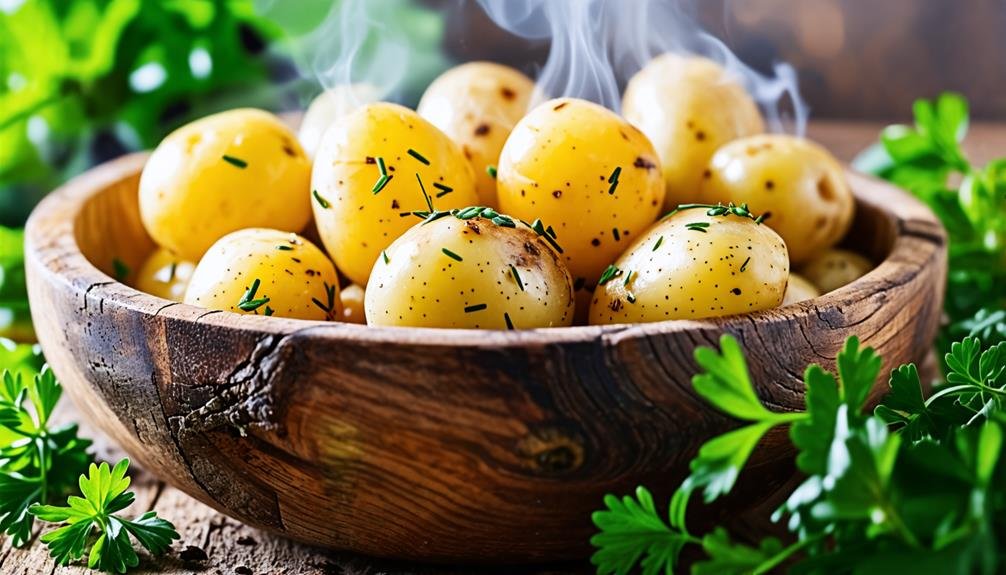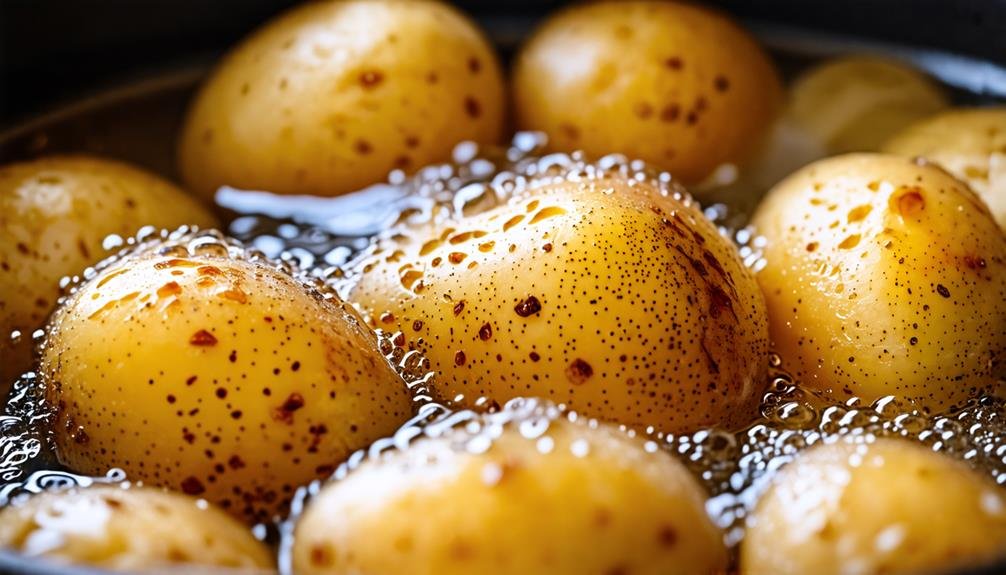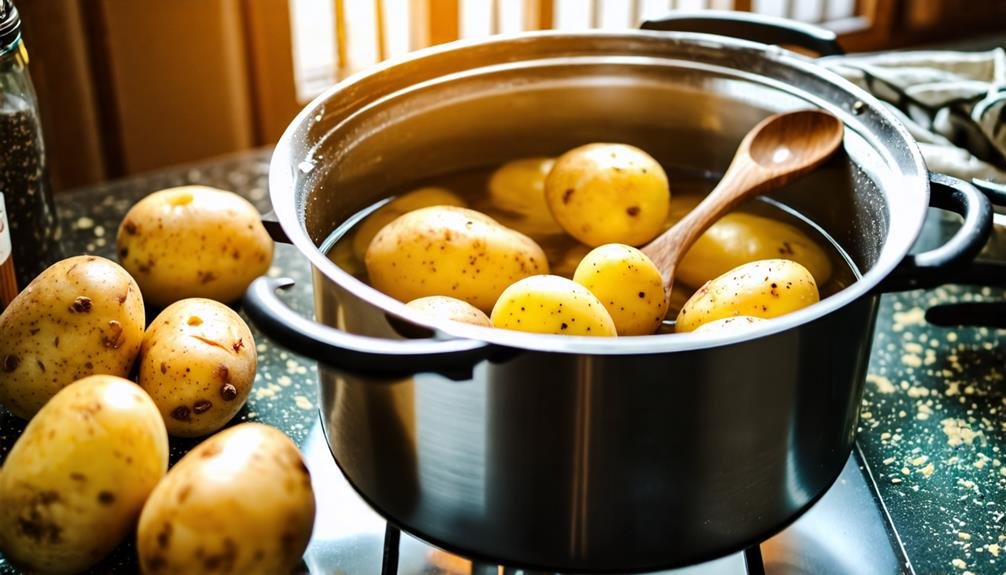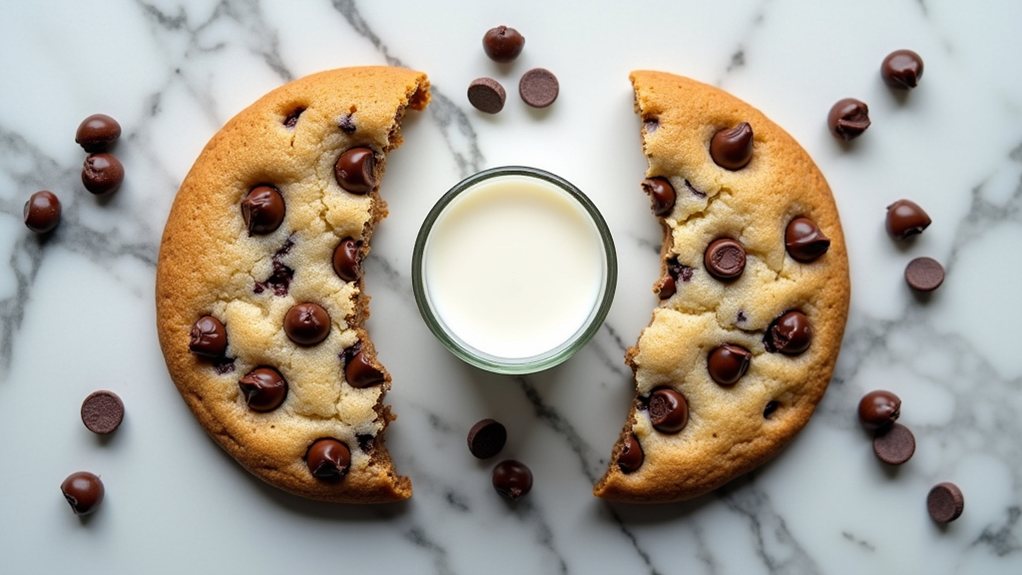Starting boiled potatoes in cold water is crucial for ensuring even cooking and preserving texture. This technique slowly heats the potatoes, enabling them to cook evenly, which prevents the outer layer from becoming mushy while the inside remains firm. Cold water also assists in removing excess starch, improving the final cooked flavor and texture. It also helps preserve the potatoes' appearance, preventing browning and oxidation. Using pieces of equal size further boosts cooking efficiency. By embracing this method, you can achieve the ideal boiled potato, benefiting from various culinary uses and improved outcomes in your recipes. More insights are on the horizon.
Benefits of Starting in Cold Water
Starting potatoes in cold water ensures even cooking. Cold water allows the tubers to heat uniformly, preventing the outer layers from becoming mushy while the interior cooks thoroughly. This method is crucial for maintaining the desired texture, avoiding the rapid cooking that boiling water can cause.
Furthermore, beginning with cold water helps keep peeled potatoes looking fresh. Exposure to air can cause oxidation, leading to brown spots; cold water minimizes this effect. Additionally, cooking in cold water aids in removing excess starch, which is beneficial for achieving crispy textures when frying, especially when using brands like McCain or Ore-Ida for frozen potato products.
Techniques for Even Cooking
To achieve even cooking of potatoes, it's crucial to ensure that all pieces are of uniform size. This consistency allows for equal cooking times and textures across the dish. Start by chopping potatoes into similar-sized cubes, which can help you manage the cooking duration effectively. Smaller chunks will cook quicker, so adjust their size based on your desired cooking time.
To check for doneness, use a knife to pierce the potatoes periodically. This method helps you quickly identify any undercooked pieces. By maintaining uniformity in size, you avoid the risk of some pieces turning mushy while others stay firm, ensuring a perfectly cooked dish every time.
Importance of Size Uniformity

Size consistency in potato preparation is important for ensuring consistent cooking times across all pieces. When potatoes are cut to similar sizes, they cook evenly, which greatly reduces the uncertainty involved in determining their doneness. This consistency not only aids in achieving the desired texture but also improves cooking efficiency, allowing for a more streamlined culinary process.
Consistent Cooking Times
Uniform potato sizes lead to consistent cooking times, ensuring every piece reaches the desired doneness together. When cut evenly, potatoes heat uniformly, preventing overcooking or undercooking. This accuracy enhances the cooking process.
Consider these benefits of maintaining size uniformity:
- Reliable cooking times: Evenly sized potatoes cook at the same pace, eliminating uncertainty in checking doneness.
- Uniform texture: Each potato heats evenly, resulting in a consistent texture from the skin to the core.
Achieving Desired Texture
Achieving the perfect texture in boiled potatoes depends on ensuring uniformity in size. When potato pieces are cut consistently, they cook evenly, allowing each chunk to reach optimal tenderness at the same time. This is vital for texture, as irregularly sized potatoes can lead to some becoming mushy while others stay undercooked.
To achieve this, cut your potatoes into chunks measuring about one to two inches. This technique promotes even cooking from the skin to the center, making it easier to gauge doneness—a key element for any home cook striving for excellence.
Additionally, maintaining consistent sizes enhances overall cooking efficiency, simplifying the preparation process. By cutting potatoes uniformly, you can relish a dish of fluffy, evenly cooked potatoes that please the palate. Investing time in proper sizing is a simple yet significant way to elevate your boiled potatoes, turning them into a memorable dish suitable for any gathering.
Additional Advantages of Cold Water
Starting potatoes in cold water offers several significant benefits that improve both their appearance and texture. By preserving the pristine look of peeled potatoes and preventing the formation of unsightly brown spots caused by oxidation, this method contributes to a visually appealing dish. Removing excess starch during the cooking process promotes crispiness, particularly beneficial for fried potatoes, ultimately elevating the overall taste and texture.
Preserves Potato Appearance
Boiling potatoes in cold water preserves their appearance and prevents browning. This method ensures that the tubers maintain their natural look, enhancing their quality in dishes like potato salad or mashed potatoes.
Benefits of Cold Water Boiling:
- Uniform Cooking: Starting with cold water ensures that all potatoes, whether Yukon Gold or Russet, cook evenly, eliminating the risk of uneven browning.
- Visual Appeal: By avoiding oxidation, boiled potatoes retain their vibrant color, making them more attractive on the plate.
Integrating cold water boiling into your potato preparation not only elevates the taste but also ensures your potatoes are visually enticing, enhancing any dining experience.
Prevents Oxidation Effects
Using a cold water technique stops the oxidation of peeled potatoes. This preserves their fresh look and avoids unattractive brown spots. When potatoes contact air, enzymes react with oxygen, causing discoloration. This browning diminishes the appeal of your dish, making it less inviting. By starting with cold water, you reduce this exposure, allowing the potatoes to retain their bright color during cooking.
Preventing oxidation enhances visual quality and elevates the overall standard of your dish. This preserved look is crucial for meals where presentation is key, like salads or gourmet recipes. Halting oxidation also lets the potatoes' natural flavors shine, unblemished by browning.
Boiling potatoes in cold water is a straightforward solution to a common kitchen issue. It encourages a method that honors the ingredients, enabling you to prepare meals that are both beautiful and tasty. This approach fosters a greater appreciation for the cooking process, giving you the freedom to explore your culinary creativity.
Enhances Fried Potato Crispiness
Soaking potatoes in chilled water before frying greatly enhances their crispiness. This technique effectively reduces excess starch, which is crucial for achieving that perfect crunch. Excess starch can create a gummy layer, hindering the formation of a golden, crispy exterior during frying. By using chilled water, the starch is drawn out, allowing for better texture.
By incorporating this simple method, you will experience several advantages:
- Superior texture: The reduction of starch results in a more appealing and satisfying crunch.
- Enhanced flavor: Crispier potatoes, like those from brands such as McCain or Ore-Ida, can better absorb seasonings, improving their overall taste.
Preserving Appearance of Potatoes

Starting potatoes in cold water prevents browning. When potatoes meet air, a reaction darkens the flesh. Using cold water reduces this effect and keeps the potatoes looking good during cooking.
Also, cold water ensures even cooking. As the temperature rises slowly, potatoes heat uniformly, avoiding uneven texture. This is especially helpful for peeled potatoes, which brown easily. Keeping their appearance enhances the dish's look and shows care in preparation.
Furthermore, cold water helps retain nutrients. By reducing oxidation, essential vitamins remain intact, making meals healthier. Thus, starting potatoes in cold water is a simple method that boosts visual appeal and preserves nutritional value, leading to a more enjoyable dining experience.
Enhancing Flavor and Texture
Starting potatoes in cold water enhances their flavor and texture. Cold water helps potatoes absorb moisture evenly, resulting in a creamy interior and balanced taste. When starches hydrate gradually, potatoes avoid gumminess that can occur with boiling water.
Here are key benefits of cooking potatoes from cold water:
- Flavor Enrichment: Potatoes, when cooked from cold, absorb seasonings better, leading to a tastier dish.
- Texture Preservation: Gradual heating maintains the potatoes' firmness, yielding a tender texture perfect for various dishes.
Tips for Perfect Boiled Potatoes

To achieve perfectly boiled potatoes, focus on preparation and cooking techniques. Start with uniform-sized tubers for consistent cooking. Cut larger ones into equal pieces to ensure even textures. Place the potatoes in a pot, covering them with cold water for gradual heating and even cooking.
Monitor cooking times carefully. Small to medium potatoes typically cook in 15 to 20 minutes, while larger ones may take up to 30 minutes. Use a knife to check doneness; it should slide through the potato effortlessly. Enhance flavor by adding herbs or garlic to the water.
Experimenting with different potato varieties, like Yukon Gold or Russet, can create diverse textures, elevating your dining experience. Paying attention to each step in preparation and cooking can transform boiled potatoes from a simple side dish into a delightful accompaniment. Enjoy perfecting this staple in your kitchen!
Avoiding Common Cooking Mistakes
To achieve perfectly boiled potatoes, avoid common mistakes that can affect their texture and flavor.
- Starting with warm water: Using warm water can lead to uneven cooking, making the outside mushy while the center remains firm. Always use cold water for consistent results.
- Overfilling the pot: Cooking too many potatoes at once can lower the water temperature, resulting in uneven cooking. It's better to prepare them in smaller batches to ensure even heat distribution.
Selecting the Right Potato Varieties

Selecting the right potato variety is key to achieving the perfect texture and flavor in your recipes. Different potato types have distinct features that significantly impact your culinary results. Starchy potatoes, like Russet, excel at mashing and baking because of their airy flesh. Waxy varieties, such as Red or New Potatoes, maintain their shape when boiled, making them excellent for salads and stews.
For rich, creamy mashed potatoes, choose Yukon Gold for its buttery taste and smooth consistency. If crispy fries are your goal, opt for high-starch options like Idaho or Maris Piper, celebrated for their ability to achieve a delightful crunch.
Don't shy away from trying specialty potatoes, such as fingerlings or Purple Peruvian, which can bring vibrant colors and distinct flavors to your meals. Ultimately, selecting the appropriate potato enhances both taste and the overall dining experience. With a plethora of varieties to explore, embracing this diversity allows you to craft dishes that showcase your culinary flair.









